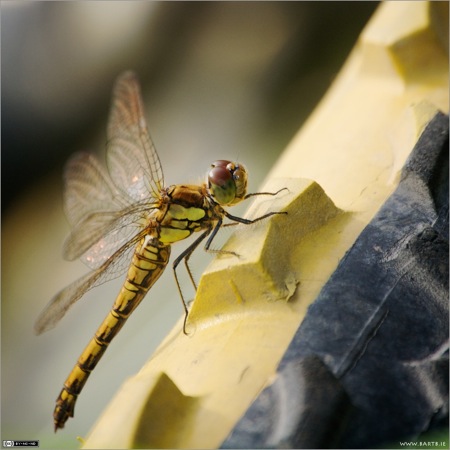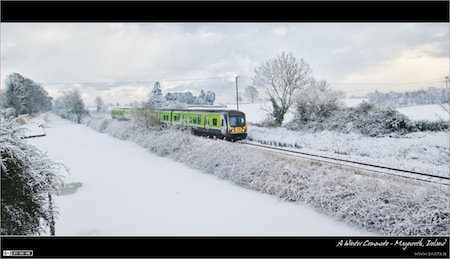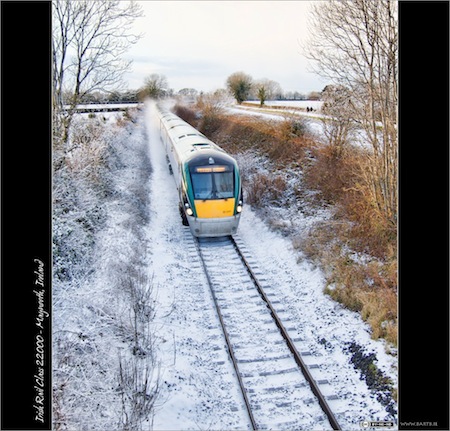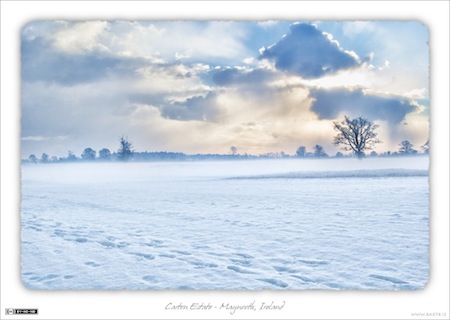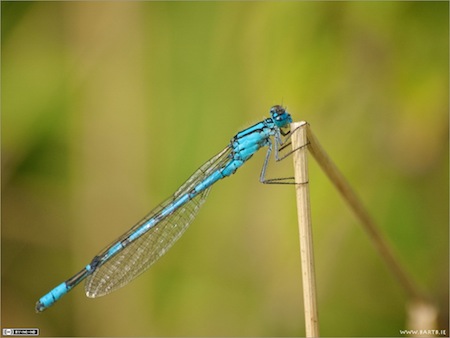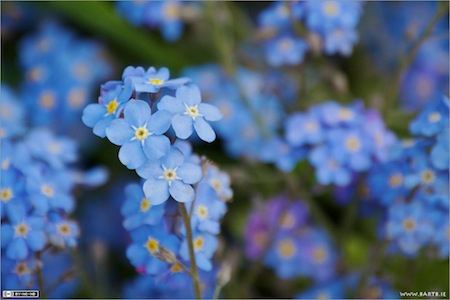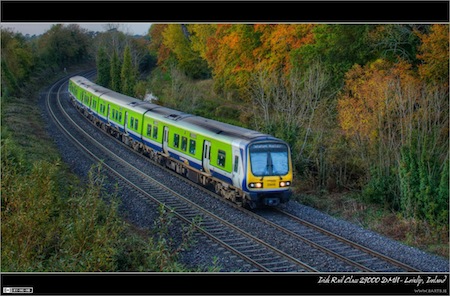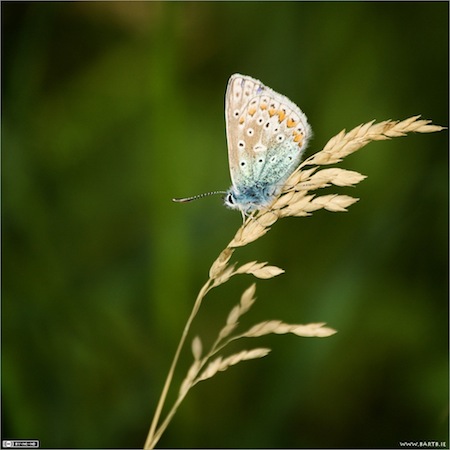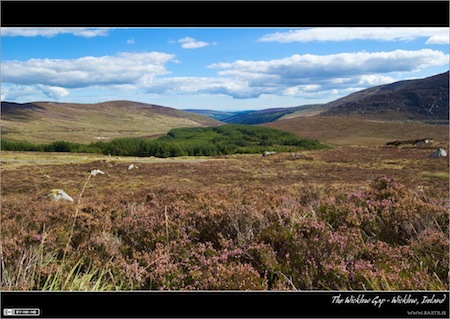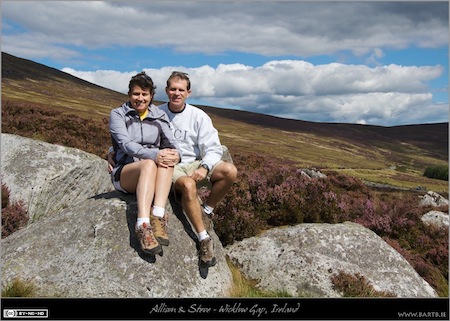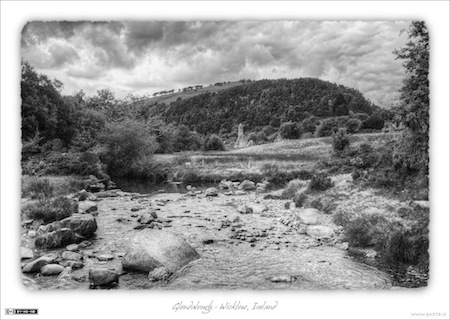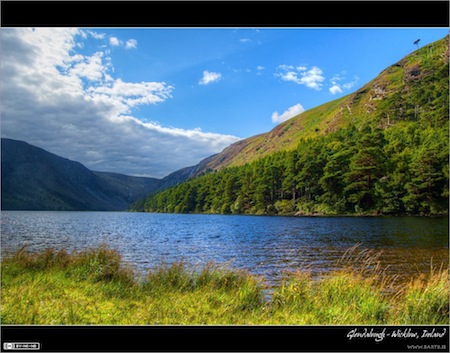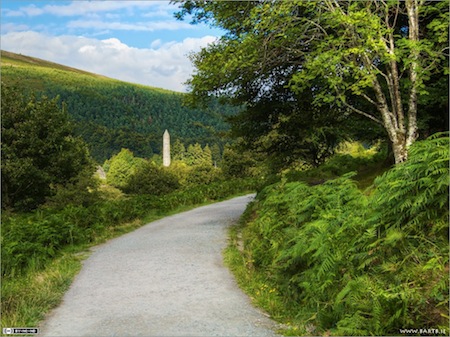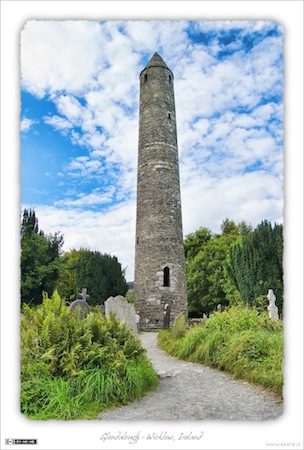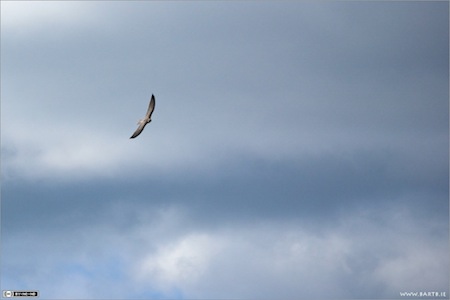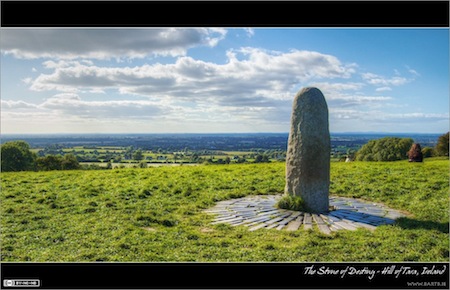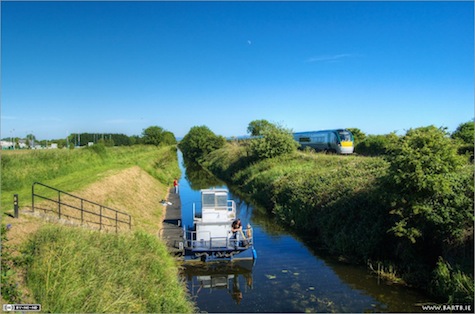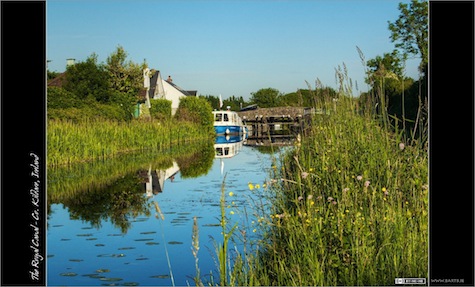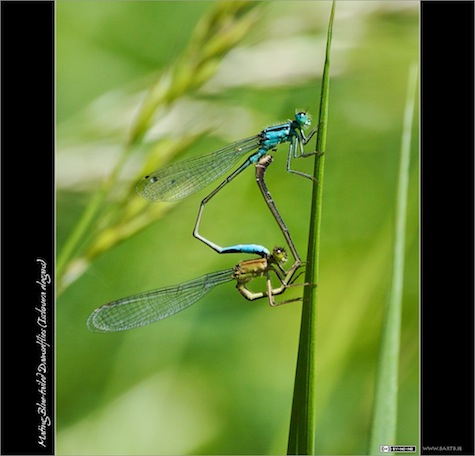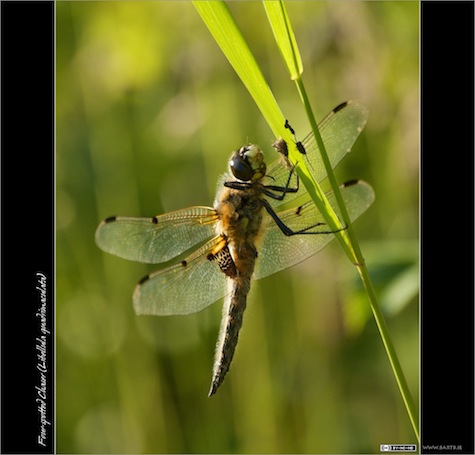Dec
22
Photo of the Week 149 – Common Darter
Filed Under Photography on December 22, 2010 | Leave a Comment
I’ve had quite enough of all this snow and cold at this stage, so I thought I’d go back to some shots from my new project this year, dragonflies and damselflies. The shot I’ve chosen for today shows a very common kind of dragonfly we see a lot around rivers, lakes, and canals in Ireland, the Common Darter (Sympetrum striolatum). This shot was in some ways very serendipitous – I’d put my bike down along the canal and was waiting for some butterflies or dragonflies to come by, when I noticed that the yellow walls of the the tyres on my bike seems to actually attract this guy! Maybe it looked like a massive yellow flower or something, or maybe it was just nice and warm. What ever his reason was, he sat there happily for about 10 minutes, and let me get as close to him as my lens could focus. I tried about 100 shots from different angles, with different depths of field, and with and without varying amounts of fill flash, but I settled on this one as my favourite. To give you some idea of how ruthlessly I often edit my images down, of the approximately 100 shots I took of this guy, I kept five!
- Camera: Nikon D40
- Lens: Nikon DX AFS 55-200mm
- Exposure: 1/400 sec
- Focal Length: 200mm
- Focal Ratio: f/8
- ISO: 400
- Camera Mode: Aperture Priority
- Flash: manually turned on (for fill flash)
- Flash Exposure Compensation: -3.0ev
- Processing: cropped to a square and tweaked with Aperture’s built-in Dodge & Burn plugin
Dec
15
Photo of the Week 147 & 148 – Winter Trains
Filed Under Photography on December 15, 2010 | 2 Comments
Despite the fact that it’s been thawing for 5 days now, there is still an inch of ice on the street in front of my house, so I figured it might be appropriate to stick to a winter theme for this double post. I’m still ill, so none of these shots are from our recent cold snap, but instead, from the one before that, in January this year. Knowing my fascination with trains I’m sure no one will be surprised that I’ve picked two railway shots for this post.
The first shot I’ve chosen is of an Irish Rail Commuter train taken from Pike’s Bridge near Maynooth. This is a Class 29000 Diesel Multiple Unit (DMU), and it’s making it’s way from Dublin to Maynooth. The frozen water in the foreground is the Royal Canal.
- Camera: Nikon D40
- Lens: Nikon DX AFS 18-55mm (D40 kit lens)
- Exposure: 1/160 sec
- Focal Length: 18mm
- Focal Ratio: f/8
- ISO: 200
- Camera Mode: Aperture Priority
- Exposure Bias: 1.0ev
- Processing: created by merging the original version of this shot with a version enhanced using the Topaz Adjust plugin
The second shot shows an Irish Rail InterCity service from Sligo to Dublin approaching Jackson’s Bridge near Maynooth. This is also a DMU, but this time of the newer and more comfortable Class 22000.
- Camera: Nikon D40
- Lens: Nikon DX AFS 18-55mm (D40 kit lens)
- Exposure: 1/320 sec
- Focal Length: 22mm
- Focal Ratio: f/3.8
- ISO: 200
- Camera Mode: Aperture Priority
- Exposure Bias: 0.67ev
- Processing: tweaked using the Topaz Adjust plugin
Dec
2
Photo of the Week 146 – Snow in Carton
Filed Under Photography on December 2, 2010 | 4 Comments
It’s unseasonably cold and snowy here in Maynooth at the moment. The snow has now been on the ground for days, and temperatures are staying below freezing day and night. I’m still sick so rather than enjoying this cold snap’s photographic opportunities I’m sitting at home grumbling about how awkward it makes everything, and praying that heating doesn’t break down again! Still – it did remind me to go have a look at some of my shots from the last unseasonable cold snap we had, in January this year. This is not the first shot from that cold snap to make it to this Photo of the Week series, but it’s definitely a worthy addition IMO.
This shot was taken in the grounds of Carton Estate on the outskirts of Maynooth. The mist that hung over the snow-covered landscape gave it a wonderful other-worldly feel. By shooting into the sun that feel was magnified even more. To get the detail out of this shot I first processed the RAW file in Aperture, and then round-tripped it through the Topaz Adjust plugin to really get it as close to what it felt like to be there as I could.
- Camera: Nikon D40
- Lens: Nikon DX AFS 18-55mm (D40 kit lens)
- Exposure: 1/320 sec
- Focal Length: 22mm
- Focal Ratio: f/8
- ISO: 200
- Camera Mode: Aperture Priority
- Exposure Bias: 1.33ev
- Processing: RAW initially processed with Aperture, tweaked using Topaz Adjust plugin
Nov
24
Photo of the Week 145 – The Common Blue Damselfly
Filed Under Photography on November 24, 2010 | Leave a Comment
Last summer I mostly concentrated on wild flowers and Butterflies, this summer, I concentrated on Butterflies, Dragonflies and Damselflies. I’ve already shared a lot of my Butterfly shots in this series, and a Dragonfly one earlier in the year, so now I thought I’d share one of my favourite Damselfly shots from this summer.
This little guy is a male Common Blue Damselfly (Enallagma cyathigerum). As their name suggests this species are very blue, and not very rare, at least not along the banks of the Royal Canal. There is a complication though, there are three common species of blue damselfly along the canal, and they can look very similar to each other indeed! The key to telling them apart is the exact details of their markings. This angle doesn’t show it very well, but the Common Blue has a club-shaped black mark on the first segment after the wings. If you look carefully you can just about see it in this shot. If that club-shaped marking were to be u-shaped instead, then this would be an Azure Damselfly (Coenagrion puella).
These guys are smalL shy, and very fast, which makes them quite challenging to photograph. I don’t have a traditional macro lens anyway, but if I did, I don’t think I’d use it for Damselfly shots anyway. All my Damselfly (and most of my Butterfly) shots are taken with my trusty 55-200mm zoom, usually at full stretch at 200mm. Using a zoom rather than a macro lets me get closeup shots from a little further away, though it does come at a price. Zoom lenses compress distance, and the closer you are to your subject, the more pronounced this effect is. This results in a very shallow depth of field, so you need to stop down quite a bit before you get enough depth to get meaningful shots. Zooming in also magnifies any little shake in your hand, so as well as using a small aperture to get the DOF, you also have to use a fast shutter speed to get sharp focus. Both a small aperture and a fast shutter cut down the light a lot, so you really need a lot of light to get the shot – so, you generally need to shoot on sunny afternoons. This is not that big of a problem though, because Damselflies like the sun too! With a lot of patience and perseverance, and perhaps a little luck, you can get some nice shots of these wonderful insects without the need for fancy expensive kit.
As I tried more and more damselfly shots over the summer, I soon got plenty of sharp ones, but the problem was getting a good background. These little fellas like to hide between long grass, so you tend to get grass poking into the frame all over the place, causing a lot of clutter in the background, and often even sticking in front of parts of the insect’s body, wings or tail. My perseverance paid off though, and later in the summer I got lucky when this guy posed for me on the tallest blade of grass along a bank – he was close to eye-level, and was happy to sit there while I got close enough to get this shot. Because he was on the tallest blade of grass, there was no clutter to get in the way, and I was able to angle the camera to get the nearest background object to be far enough away to be fully out of focus, giving this nice uncluttered shot
- Camera: Nikon D40
- Lens: Nikon DX AFS 55-200mm
- Exposure: 1/400 sec
- Focal Length: 200mm
- Focal Ratio: f/8
- ISO: 400
- Camera Mode: Aperture Priority
Nov
15
Photo of the Week 144 – Forget-me-not
Filed Under Photography on November 15, 2010 | Leave a Comment
It’s been a while since I’ve chosen a flower photo for Photo of the Week, so I decided to remedy that this week. This is a shot of one of my favourite little flowers, they have a fantastic pale blue colour, and wonderfully fine details in their tiny flowers. It can be quite hard to tell the different varieties of Forget-me-not apart, but I think this is Field Forget-me-not (Myosotis arvensis).
- Camera: Nikon D40
- Lens: Nikon DX AFS 55-200mm
- Exposure: 1/640 sec
- Focal Length: 200mm
- Focal Ratio: f/5.6
- ISO: 400
- Camera Mode: Aperture Priority
Nov
11
Photo of the Week 143 – Autumn Boat Train
Filed Under Photography on November 11, 2010 | 1 Comment
With this long-drawn out illness the past few months I’ve literally missed all the Autumn colour this year. So, since I got no new autumnal pictures this year, I thought I’d share of of my favourites from last year.
Here we see an evening train service from Maynooth to the port in Rosslare as it rounds the fairly sharp turn on the approach to the new Matt Goff Bridge just in Leixlip. This shot has been quite heavily tonemapped to bring out the best of the colours, I have a feeling some people may find the processing a little too extreme, but I like it, and since it’s my photo that’s all that matters 😉
For the train spotters among you, this is an Irish Rail Class 29000 railcar set, number 29018 to be precise. If you have good eyesight you can probably read the number on the front of the train which reads 29418, it will read 29118 on the other side, and the middle two carriages will have the numbers 29218 and 29318, hence the whole unit is referred to as 29018. These units come in blocks of 4, but can be joined together to make larger trains of 8 or even 12 carriages. The 29000s are very much the work horses for Irish Rail’s commuter and local services, though you do sometimes see them on longer national routes too. From a passenger comfort point of view, they’re fine for short services, but I’m not along in groaning when I see one pull up to the platform when I’m travelling InterCity.
- Camera: Nikon D40
- Lens: Nikon DX AFS 18-55mm (D40 kit lens)
- Exposure: 1/200 sec
- Focal Length: 30mm
- Focal Ratio: f/3.5
- ISO: 200
- Camera Mode: Full Manual
- Processing: created by tonemapping a single RAW image with Photomatix Pro, and then tweaking the resulting image with Aperture’s built-in Dodge & Burn plugin
Nov
1
Photo of the Week 142 – The Common Blue
Filed Under Photography on November 1, 2010 | 1 Comment
One of my favourite muses this year has been the Common Blue butterfly (Polyommatus icarus). It’s just so beautiful, and this was a good year for them in Ireland. The summer’s long gone now, but it comes back to me vividly when I look at this shot.
This is definitely one of my favourite shots of the Common Blue from this year. In many ways this is very clichéd shot, these guys love sitting on grass seed stalks, so you see loads of shots of them in this pose. However, this ones stands out to me because of the wonderful soft evening light, and the strong contrast between the butterfly and the background. This was possible because this guy was friendly enough to sit on a grass stalk that was in sunlight, while the background behind it was in shade.
- Camera: Nikon D40
- Lens: Nikon DX AFS 55-200mm
- Exposure: 1/400 sec
- Focal Length: 200mm
- Focal Ratio: f/8
- ISO: 400
- Camera Mode: Aperture Priority
- Exposure Bias: -0.7ev
Oct
25
Photo of the Week 134 to 141 – Allison & Steve Visit Ireland
Filed Under Photography on October 25, 2010 | Leave a Comment
If you’ve been wondering why I’ve gotten so far behind with my Photo of the Week, the simple answer is that I’ve been ill. To cut a long story short, viruses are evil, and modern medicine seems powerless against them. I’m determined to get back on track with this series though, so this is an 8-photo bumper edition! Just before I fell badly ill Allison & Steve Sheridan (of the NosillaCast Podcast) came to Ireland for a short visit, so I’ve chosen my favourite 8 shots form their stay for this instalment. (You can see more shots form the visit on Flickr)
On their first full day in Ireland we went for a drive around the Wicklow mountains. We started off at the lakes in Blessington, then crossed the Wicklow Gap to Glendalough, and returned home by Military Road and the Sally Gap.
I did take some shots in Blessington, but I didn’t think any of them were worthy of a Photo of the Week spot, so the first picture I’m posting was taken at the top of the Wicklow gap looking east towards Glendalough.
- Camera: Nikon D40
- Lens: Nikon DX AFS 18-55mm (D40 kit lens)
- Exposure: 1/160 sec
- Focal Length: 18mm
- Focal Ratio: f/11
- ISO: 200
- Camera Mode: Aperture Priority
- Processing: tweaked a little using the Topaz Adjust plugin
The second shot I’ve chosen was also taken at the top of the Wicklow Gap, and it’s my favourite shot of Allison & Steve from the trip.
- Camera: Nikon D40
- Lens: Nikon DX AFS 18-55mm (D40 kit lens)
- Exposure: 1/400 sec
- Focal Length: 30mm
- Focal Ratio: f/11
- ISO: 200
- Camera Mode: Aperture Priority
The third shot I’ve chosen was in Glendalough. It’s undoubtedly a clichéd shot, but I like my take on it all-the-same. The light was very poor, with a massive dynamic range, so I opted to shoot in RAW, tonemap, and then convert to a very dramatic monochrome to really emphasise the textures. By using the channel mixer for the conversion I was able to make the building really stand out by pushing the red channel very high, and taking the blue and green channels down low.
- Camera: Nikon D40
- Lens: Nikon DX AFS 18-55mm (D40 kit lens)
- Exposure: 1/200 sec
- Focal Length: 26mm
- Focal Ratio: f/11
- ISO: 400
- Camera Mode: Aperture Priority
- Exposure Bias: -1.0ev
- Processing: first tonemapped the original RAW with Photomatix Pro, then tweaked a little using Topaz Adjust plugin, then converted to monochrome using the Channel Mixer brick in Aperture.
The fourth shot I’ve chosen was from the end-point of our walk in Glendalough, the shore of the Upper-Lake. Just as we were about to turn around and head back to the car a small patch of blue sky passed over giving us a momentary burst of sun.
- Camera: Nikon D40
- Lens: Nikon DX AFS 18-55mm (D40 kit lens)
- Exposure: 1/640 sec
- Focal Length: 18mm
- Focal Ratio: f/8
- ISO: 200
- Camera Mode: Aperture Priority
- Exposure Bias: -1.0ev
- Processing: first tonemapped the original RAW with Photomatix Pro, then tweaked a little using Topaz Adjust plugin, before giving it some final tweaks using Aperture’s Dodge & Burn plugin.
As we were walking back towards the visitor centre from the Upper Lake we had some fantastically good luck, just as we had a perfect view of the round tower, the sun picked it out perfectly, while leaving the mountain behind it in shadow. The result was to make the tower appear bright white against a deep green background.
- Camera: Nikon D40
- Lens: Nikon DX AFS 18-55mm (D40 kit lens)
- Exposure: 1/250 sec
- Focal Length: 35mm
- Focal Ratio: f/8
- ISO: 200
- Camera Mode: Aperture Priority
- Exposure Bias: -0.7ev
- Processing: first tonemapped the original RAW with Photomatix Pro, then tweaked a little using Aperture’s Dodge & Burn plugin.
Having come back from our walk we headed over to the ruins of the monastic village before heading home for the day. We were lucky enough to get a few more breaks in the clouds which made this shot of the round tower possible. I’m really happy with the composition I managed to pick out with the the little winding path leading to the tower.
- Camera: Nikon D40
- Lens: Nikon DX AFS 18-55mm (D40 kit lens)
- Exposure: 1/400 sec
- Focal Length: 18mm
- Focal Ratio: f/8
- ISO: 400
- Camera Mode: Aperture Priority
- Exposure Bias: +0.7ev
- Processing: first tonemapped with the Topaz Adjust plugin, then tweaked a little using Aperture’s Dodge & Burn plugin.
The last two images I want to share from the visit were taken on Al & Steve’s last day here, when we visited the Hill of Tara on a beautifully sunny but rather blustery afternoon. Through pure luck we arrived just in time to catch a falconry demonstration! The bird was really loving the strong winds, and the sky was quite dramatic, so I was able to get some nice shots of her flying. This first shot from Tara is my favourite of the inflight shots I got.
- Camera: Nikon D40
- Lens: Nikon DX AFS 55-200mm
- Exposure: 1/3200 sec
- Focal Length: 200mm
- Focal Ratio: f/8
- ISO: 400
- Camera Mode: Aperture Priority
- Exposure Bias: -0.7ev
Finally, the last picture for today’s bumper post is a view from the top of the Hill of Tara out across the Irish midlands. The stone in the foreground is the so-called Stone of Destiny, where the Irish High Kings were crowned.
- Camera: Nikon D40
- Lens: Nikon DX AFS 18-55mm (D40 kit lens)
- Exposure: 1/1000 sec
- Focal Length: 23mm
- Focal Ratio: f/8
- ISO: 400
- Camera Mode: Aperture Priority
- Processing: first tonemapped the original RAW with Photomatix Pro, then tweaked a little using Topaz Adjust plugin.
Sep
5
Photo of the Week 132 & 133 – The Royal Canal
Filed Under Photography on September 5, 2010 | 3 Comments
There’s been a lot of double posts of late, and this week is no exception. Last week I happily entertaining Allison & Steve from the Nosillacast on the Irish leg of their European tour, so I didn’t get a chance to post. As always with double posts, I’ve chosen two related photos, in this case both of the Royal Canal. The vast majority of my insect and flower shots, as well as many of my train shots, are taken along a 10 mile stretch of this canal from Leixlip to Maynooth to Kilcock. Despite sharing lots of shots taken along the canal, I hardly ever share any shots of the canal, so I thought I’d correct that oversight this week.
The first shot I’ve chosen is taken from Chamber’s Bridge just east of the 15th lock looking east towards Dublin. In the foreground you can see the jetty where boats can tie up while waiting to pass the lock which is directly behind us. The boat tied up at the jetty is a very special boat used by Waterways Ireland to keep the canal clear of too much plant growth. You can also see a guy fishing from the boat, and an evening express train to Sligo passing by on an embankment above the canal.
- Camera: Nikon D40
- Lens: Nikon DX AFS 18-55mm (D40 kit lens)
- Exposure: 1/800 sec
- Focal Length: 18mm
- Focal Ratio: f/8
- ISO: 400
- Camera Mode: Full Manual
- Processing: This image was tweaked a little using the Topaz Adjust 4 plugin in Photoshop Elements 8.
The second shot was taken on the other side of the 15th lock, also looking east. Although the canal has been fully restored around the Dublin area, it’s still a work in progress further west, which means there isn’t much tourism on the canal yet. One of the few places you do see signs of tourism is here at the mooring place just west of the 15th lock. Lets hope views like this become more common all along the Royal Canal.
- Camera: Nikon D40
- Lens: Nikon DX AFS 18-55mm (D40 kit lens)
- Exposure: 1/500 sec
- Focal Length: 55mm
- Focal Ratio: f/11
- ISO: 400
- Camera Mode: Aperture Priority
- Exposure Bias: -0.3ev
- Processing: Generated by tonemapping a single RAW image with Photomatix Pro, and then tweaking the result with the Topaz Adjust 4 plugin in Photoshop Elements 8
Aug
24
Photo of the Week 130 & 131 – Two New Muses
Filed Under Photography on August 24, 2010 | 2 Comments
For a long time now my two favourite subjects have been trains and butterflies, but this year I’ve started to be attracted by two related new muses. Butterflies are probably the most eye-catching insects in Ireland, but I think the largest are the Dragonflies and Damselflies that fill our summer skies. I’ve only been focusing on these guys for a few months, but I’ve already got some pictures I like enough to include here.
The first shot I’ve chosen shows a pair of Blue-tailed Damselflies (Ischnura elegans) making more Blue-tailed Damselflies. Two things to note here, firstly, Damselflies opt for a very unique position for mating, and the males and females have very different colours. Adult males of the different species generally look quite distinct (with a few exceptions), but many of the females of the different species look very similar, some species even have females of a few different colours, and to really confuse things, both males and females change colour as they mature. If you can’t recognise what species a Damselfly is, it’s probably a juvenile, or a female, or both. Butterflies are WAY easier to tell apart!
- Camera: Nikon D40
- Lens: Nikon DX AFS 55-200mm
- Exposure: 1/800 sec
- Focal Length: 200mm
- Focal Ratio: f/8
- ISO: 200
- Camera Mode: Aperture Priority
- Exposure Bias: -1.0ev
- Processing: tweaked a little using Aperture’s Dodge & Burn plugin
The second shot I chose is of the largest Dragonfly I’ve managed to capture so far, the Four-spotted Chaser (Libellula quadrimaculata). These guys are very territorial. They get their name because they chase away other Dragonflies that stray into their patch (and have 4 spots on each set of wings). They like to sit on perches that give them a good view of their territory, and will keep returning to their favourite perches over and over again. This makes them a joy to photograph, if you miss the perfect shot the first time around, just wait a bit, and you’ll get another chance! The fact that they like a perch with a good view also means you tend to be able to get shots with nice clutter-free backgrounds too.
I’ve also started to experiment a lot with back-lighting in the last few months. As this shot demonstrates, it can work nicely on insects which tend to have transparent or semi-transparent bits for the light to shine through.
- Camera: Nikon D40
- Lens: Nikon DX AFS 55-200mm
- Exposure: 1/400 sec
- Focal Length: 200mm
- Focal Ratio: f/8
- ISO: 400
- Camera Mode: Aperture Priority
- Exposure Bias: -1.0ev
- Processing: tweaked a little using Aperture’s Dodge & Burn plugin







